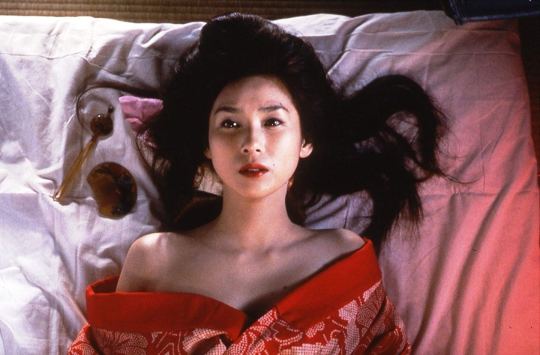#A Woman Called Sada Abe
Explore tagged Tumblr posts
Photo

(via Poster for A Woman Called Sada Abe (Jitsuroku Abe Sada) (1975, Japan) - Wrong Side of the Art)
32 notes
·
View notes
Photo


A Woman Called Sada Abe, 1975
4 notes
·
View notes
Text



“A Woman Called Abe Sada”, by Noboru Tanaka, 1975
#A Woman Called Abe Sada#Noboru Tanaka#Junko Miyashita#Japanese Cinema#Japanese Movies#Pink Eiga#Exploitation Movies#Exploitation Cinema#Abe Sada
7 notes
·
View notes
Photo



Jitsuroku Abe Sada (Noboru Tanaka, 1975)
17 notes
·
View notes
Text

(También conocida como: Una mujer llamada Sada Abe)
#movies#noboru tanaka#clasificada s#Jitsuroku Abe Sada#A Woman Called Abe Sada#Junko Miyashita#Hideaki Esumi#1975
0 notes
Photo

Hitomi Kuroki in Sada (Nobuhiko Obayashi, 1998)
Cast: Hitomi Kuroki, surutarô Kataoka, Norihei Miki, Kippei Shîna, Toshie Negishi, Bengal, Renji Ishibashi, Kyûsaku Shimada. Screenplay: Yuko Nishizawa. Cinematography: Noritaka Sakamoto. Production design: Kôichi Takeuchi. Film editing: Nobuhiko Obayashi. Music: Sotaro Manabu.
Having seen House (Nobuhiko Obayashi, 1977) and In the Realm of the Senses (Nagisa Oshima, 1976), I had to see what the director of the former -- a brightly colored, over-the-top horror film, set to a bubble-gum pop soundtrack, about a gaggle of Japanese schoolgirls who find themselves in a haunted house and proceed to die in various colorful and inventive ways -- would do with the latter -- a sexually explicit account, with full nudity and unsimulated copulation, of the crime of Sada Abe, who in 1936 killed her lover, Kichizo Ishido, carved their names on his body, and cut off his genitals, carrying them around with her until she was arrested. The story of Sada has been the subject of numerous books and at least five movies in Japan, after her trial -- which resulted in five years in prison -- set off a nationwide sensation, turning her into a kind of folk hero. The result is a curiously show-offy film that Obayashi fills with all manner of tricks: switches from color to black-and-white, characters breaking the fourth wall, eccentric cuts and startling shifts of tone, and deliberate violations of cinematic convention. In one scene, Sada (Hitomi Kuroki) and her lover, whose name has been changed to Tatsuzo (Tsurutaro Kataoka) in the film, are walking along the street together. The camera follows Tatsuzo from right to left as he speaks, then cuts to Sada as she replies. Film convention calls for a shot followed by a reverse shot, in which we see first Tatsuzo and then Sada from different angles. Instead, Obayashi cuts to Sada, filmed from the same angle and still traveling from right to left, as if she has somehow physically replaced Tatsuzo. This and similar impossible cuts and angles in the film are probably meant to suggest Sada's identification with her lover. Tone shifts mark the film from the beginning: It opens with 14-year-old Sada's rape by a teenage boy, a harrowing scene that is nevertheless somehow played as if it were comic, just as later Sada's work as a prostitute shifts into comic mode with speeded-up action and cuts to a voyeur watching from his hiding place, and a fight with Tatsuzo's wife becomes almost slapstick. Obayashi seems determined to avoid anything that smacks of melodrama or sentimentality. but not always successfully. The screenplay, by Yuko Nishizawa, tries to add depth to Sada's story by inventing a young medical student, Okada (Kippei Shina), who tends to her after her rape. He becomes a symbol of Sada's loss of anything but physical love when he is forced to part from her: He gives her his scalpel and has her mime cutting out his heart and taking it with her -- an obvious foreshadowing of her actual use of the scalpel on Tatsuzo. Sada spends much of the film hoping to be reunited with Okada, only to find that he has leprosy and has been sent to an island on the Inland Sea for quarantine. The film ends with a shot of an elderly woman looking out across the sea to the island. In contrast to Oshima's In the Realm of the Senses, Obayashi's film avoids nudity, but this only serves to add another layer of distance between the viewer and Sada. Kuroki, a beautiful young actress, does what she can with the role, but the constant camera tricks and the limitations imposed by the script never let us get more than a superficial glimpse of what drove Sada Abe to act as she did.
3 notes
·
View notes
Link
http://ift.tt/eA8V8J via DramaSerialDotTV
0 notes
Photo

A Woman Called Sada Abe http://ift.tt/2AkYrHQ
0 notes
Photo

A Woman Called Sada Abe, 1975
0 notes
Photo

実録阿部定, Noboru Tanaka (1975)
Cinematography: Masaru Mori | Japan
1 note
·
View note
Photo



Jitsuroku Abe Sada aka A Woman Called Sada Abe, 1975, Noboru Tanaka
1 note
·
View note
Photo

田中登監督「実録 阿部定」(日活-1975年)
101 notes
·
View notes